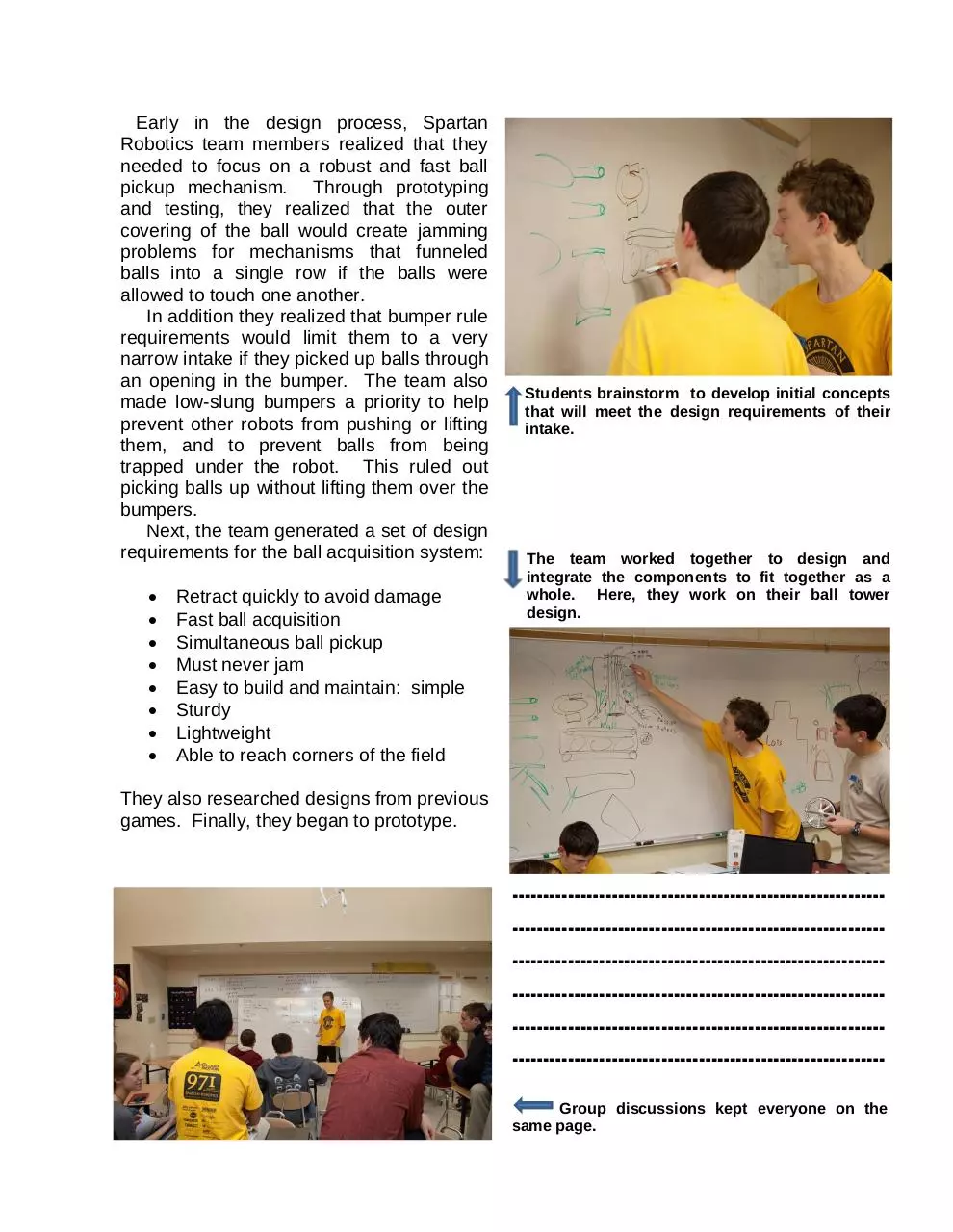2012 Behind the Design Team 971 (PDF)
File information
Author: Green
This PDF 1.5 document has been generated by Microsoft® Word 2010, and has been sent on pdf-archive.com on 10/12/2012 at 17:26, from IP address 72.55.x.x.
The current document download page has been viewed 1741 times.
File size: 1.37 MB (8 pages).
Privacy: public file





File preview
Reaching the finals in a FIRST Robotics
Regional competition requires a solid robot
and a bit of luck. Winning two consecutive
regional competitions requires a level of play
that few teams reach.
TEAM 971
A NOVEL TAKE
ON AN
HOW FOCUSSING ON
BALL ACQUISITION LED
A TEAM TO WINS IN
TWO REGIONAL
COMPETITIONS AND A
BIRTH AT WORLDS.
…………………………………………………..
…………………………………………………..
…………………………………………………..
…………………………………………………..
…………………………………………………..
…………………………………………………..
…………………………………………………..
…………………………………………………..
…………………………………………………..
…………………………………………………..
…………………………………………………..
…………………………………………………..
…………………………………………………..
Team 971 is a high-school FIRST
robotics team based in Mountain View,
California.
Their 2012 robot,
“Renegade” featured a unique intake
system was a large contributor to their
success.
A lengthy design and prototyping
process determined that having a fast
and reliable ball intake would be critical
in the 2012 game, “Rebound Rumble”.
The team even used a camera capable
of recording video at 1000 frames per
second to determine how balls moved
through intake systems to understand
where problems might appear.
Even after the team built their robot,
constant iteration with their practice
robot improved upon their initial design.
That
improvement
continued
throughout the season and up to World
Championships.
Early in the design process, Spartan
Robotics team members realized that they
needed to focus on a robust and fast ball
pickup mechanism. Through prototyping
and testing, they realized that the outer
covering of the ball would create jamming
problems for mechanisms that funneled
balls into a single row if the balls were
allowed to touch one another.
In addition they realized that bumper rule
requirements would limit them to a very
narrow intake if they picked up balls through
an opening in the bumper. The team also
made low-slung bumpers a priority to help
prevent other robots from pushing or lifting
them, and to prevent balls from being
trapped under the robot. This ruled out
picking balls up without lifting them over the
bumpers.
Next, the team generated a set of design
requirements for the ball acquisition system:
Retract quickly to avoid damage
Fast ball acquisition
Simultaneous ball pickup
Must never jam
Easy to build and maintain: simple
Sturdy
Lightweight
Able to reach corners of the field
Students brainstorm to develop initial concepts
that will meet the design requirements of their
intake.
The team worked together to design and
integrate the components to fit together as a
whole. Here, they work on their ball tower
design.
They also researched designs from previous
games. Finally, they began to prototype.
……………………………………………………
……………………………………………………
……………………………………………………
……………………………………………………
……………………………………………………
……………………………………………………
Group discussions kept everyone on the
same page.
Prototyping All
The Problems
The team narrowed down their design
choices to eight different possibilities. Each
of these was sketched up in Solidworks,
analyzed, and reviewed. After the review
the team was able to settle on one of the
concepts and started to build a mock-up of
that system using scrap material.
They decided on an over-the-bumper
acquisition system to maximize the width of
their intake. That presented them with
another problem. The team already knew
they wanted to avoid a system that
funneled the balls together in a single row.
That led them to create a unique horizontal
belt system that balls would be deposited
on by the ball intake mechanism.
The prototypes that 971 made still
exhibited some of the ball jamming that
they were trying to avoid. Most of the
jamming was occurring when balls would
rub together. The outer covering was so
sticky that the balls would not roll while
touching one another.
Spartan Robotics worked extensively
tuning the size and shape of the ball path
and trying different materials for the walls.
They also worked with a number of different
belt speeds to try to determine which
worked best.
Intentionally overloading the conveyor
helped determine what would fail first.
1000
Initial tests showed where their concepts were
going to have issues with jamming.
The
team
tweaked
components
and
measurements until the balls began to flow
through their system.
Additional iterations of their prototype helped
reduce jamming.
Duct tape and cardboard
allowed quick but effective prototypes.
The ball pickup system was made out of
hollow rectangular tubing.
The team used sheet metal heavily in
their frame, but chose to make their ball
acquisition system out of large rectangular
tube for strength.
The team used timing pulleys on the
drivetrain. Also note the new tread mounting
method, a collaborative effort that is now on
sale at AndyMark.
971’s team members also considered
the reliability of the ball acquisition
mechanism: they decided against running
their rollers with urethane cord. Urethane
cord is common in FIRST Robotics
because it is inexpensive and easy to form
into belts of any length. However, urethane
cord has a tendency to walk sideways on
rollers and come off. Instead, they ran
timing belt on timing pulleys, and packaged
the belts and pulleys inside the rectangular
tubing to protect it.
The team also used timing belts and
pulleys on their drivetrain. Timing belts are
toothed-belts that ride on similarly toothed
pulleys. They are extremely durable and
weigh little. They do have drawbacks,
however; they require addition design time
to insure the length between pulleys is
correct, because they cannot be cut and
spliced.
The drivetrain and ball handling systems were driven with lightweight timing belts.
An accurate 3D model allowed seamless integration of all the components and made potential
design revisions much easier.
The true innovation in 971’s ball pickup
mechanism was the way in which balls
transitioned
from
a
three-wide
configuration into a single row of balls that
could be fed into the vertical tower.
The speed of the rollers acquisition
system and the speed of the horizontal
conveyor itself were both tuned to smooth
the flow of balls into the vertical tower.
The speed of each conveyor system relied
on the other: too fast or too slow on either
Balls were pulled over the bumper, then would result in ball pile-ups and jamming.
deposited on the angled surface leading to
the horizontal conveyor. Gravity helped
When the speeds of both conveyors
separate the balls on their way to the were adjust correct, balls were fed single
conveyor, but if that failed then the file into the vertical tower. An optical
horizontal motion of the conveyor served sensor at the entrance to the vertical
to further separate the balls.
conveyor insured that the balls were
spaced correctly for the shooter.
………………….………………….………………….………………….………………….…..
………………….………………….………………….………………….………………………
………………….………………….………………….………………….………………………
………………….………………….………………….………………….………………………
………………….………………….………………….………………….………………………
………………….………………….………………….………………….………………………
………………….………………….………………….………………….………………………
………………….………………….………………….………………….………………………
………………….………………….………………….………………….………………………
………………….………………….………………….………………….………………………
Slick plastic plates were attached to the robot
frame in the location that it would strike the
bump as the robot traversed it. The rivets
were countersunk to provide a perfectly flat
surface.
Pneumatic cylinders actuated drop-down
wheels to lift the front of the robot to the
height of the bump.
A Bump in the Road
Having a superior ball collection
system wouldn’t help the team unless
they could get to the balls quickly. The
team designed an elegant method to
slide over the center barrier.
First they devised a method to lift the
front of the robot above the height of the
barrier.
Pneumatic cylinders were
installed on the robot that actuated
wheels under the front of the robot.
This elevated the robot’s front. They
also attached skid plates to the front of
the robot to help it slide up and over the
barrier.
Plastic runners ran under the robot
so that once the robot was on the bump,
the wheels could keep pushing and the
rails would slide across the barrier
quickly and easily.
Team 971 correctly identified the
difficulty faced by teams moving balls
through acquisition systems as one of
the key design challenges for the 2012
game. Their unique and elegant overthe-bumper to horizontal conveyor
system proved to reliably meet that
challenge.
When the intake was combined with a
highly mobile robot that could easily
traverse the bump and shoot accurately,
it resulted in a combination that was
tough to beat.
Download 2012 Behind the Design - Team 971
2012 Behind the Design - Team 971.pdf (PDF, 1.37 MB)
Download PDF
Share this file on social networks
Link to this page
Permanent link
Use the permanent link to the download page to share your document on Facebook, Twitter, LinkedIn, or directly with a contact by e-Mail, Messenger, Whatsapp, Line..
Short link
Use the short link to share your document on Twitter or by text message (SMS)
HTML Code
Copy the following HTML code to share your document on a Website or Blog
QR Code to this page

This file has been shared publicly by a user of PDF Archive.
Document ID: 0000065975.